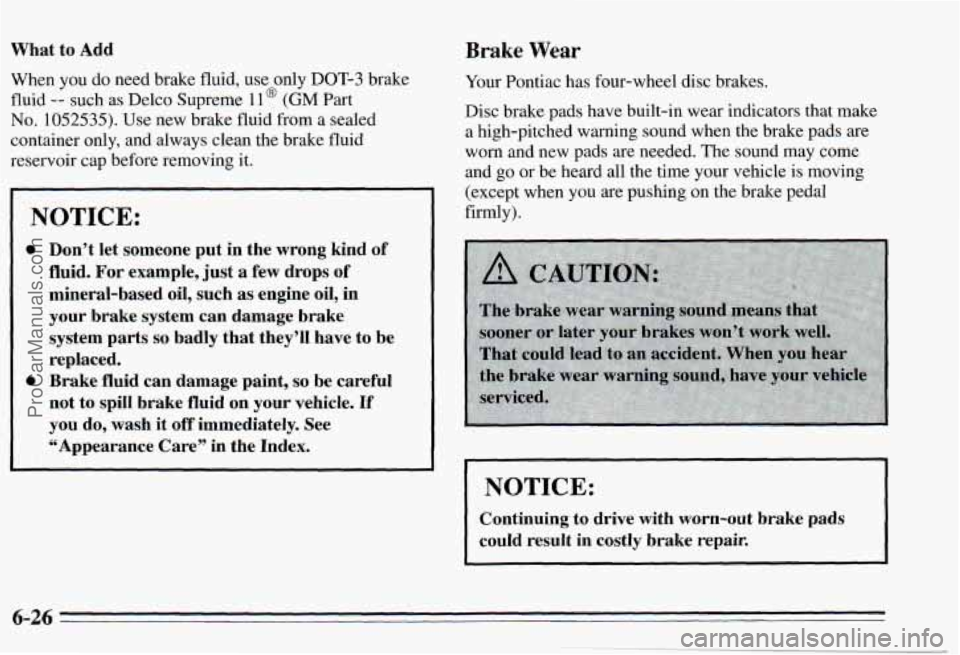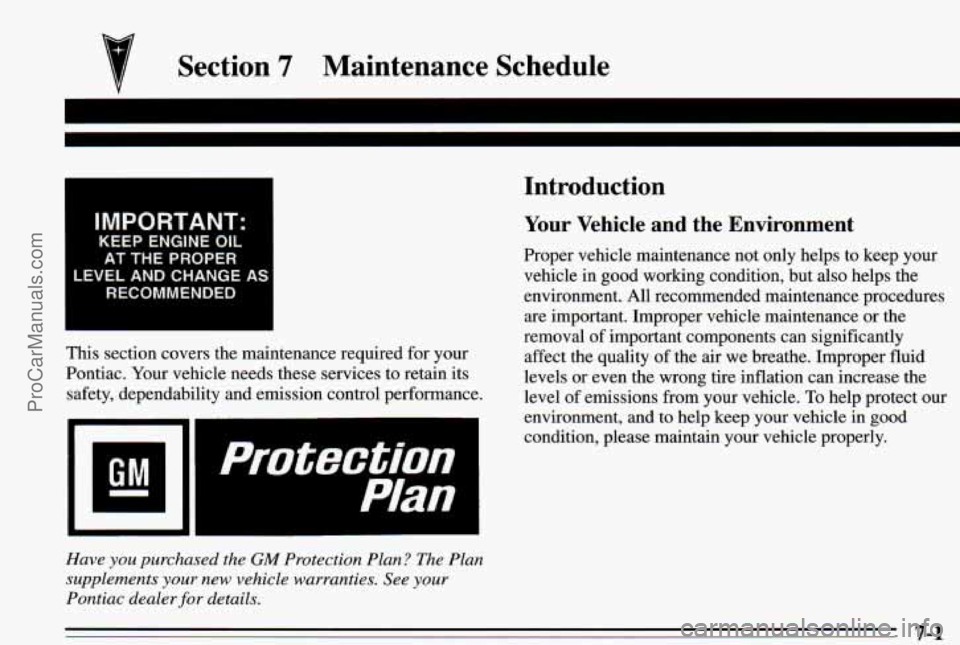Page 232 of 354

Engine Coolant
The following explains your cooling system and how to
add coolant when it is low. If you have a problem with
engine overheating
or if you need to add coolant to your
radiator, see “Engine Overheating” in the Index.
The proper coolant for your Pontiac will:
Give freezing protection down to -34°F (-37°C).
Give boiling protection up to 262°F (128 “C).
0 Protect against rust and corrosion.
Help keep the proper engine temperature.
0 Let the warning lights work as they should.
What to Use
Use a mixture of one-half
clean water (preferably
distilled) and one-half antifreeze that meets “GM Specification 1825-M,” which won’t damage aluminum
parts. You can also use a recycled coolant conforming to
GM Specification 1825-M with
a complete coolant flush
and refill. Use GM Engine Coolant Supplement (sealer)
with any complete coolant flush and refill.
If you use
this mixture, you don’t need to add anything else.
I NOTICE:
If you use an improper coolant mix, your engine
could overheat and be badly damaged. The
repair cost wouldn’t be covered by your
warranty.
Too much water in the mix can freeze
and crack the engine, radiator, heater core and
other parts.
6-19 ProCarManuals.com
Page 239 of 354

What to Add Brake Wear
When you do need brake fluid, use only DOT-3 brake
fluid
-- such as Delco Supreme 11 @ (GM Part
No. 1052535). Use new brake fluid from a sealed
container only, and always clean the brake fluid
reservoir cap before removing it.
NOTICE:
@ Don’t let someone put in the wrong kind of
fluid. For example, just a few drops of
mineral-based oil, such as engine oil, in
your brake system can damage brake
system parts
so badly that they’ll have to be
replaced.
0 Brake fluid can damage paint, so be careful
not to spill brake fluid on your vehicle.
If
you do, wash it off immediately. See
“Appearance Care” in the Index. Your
Pontiac has four-wheel disc brakes.
Disc brake pads have built-in wear indicators that make a high-pitched warning sound when the brake pads are
worn and new pads are needed. The sound may come
and
go or be heard all the time your vehicle is moving
(except when you are pushing on
the brake pedal
firmly).
NOTICE:
Continuing to drive with worn-out brake pads
could result in costly brake repair.
6-26
ProCarManuals.com
Page 285 of 354

Normal Maintenance Replacement Parts
Air Cleaner Filter
Battery
All Engines ............................. A1208C
3.1L (Code
M) ......................... 525 CCA
3.4L (Code
M) ......................... 690 CCA
3.1L (Code
M) ............................. PF47
3.4L (Code
X) .............................. PF5 1
3.1L (Code M)
.......................... CV892C
3.4L (Code
X) ........................... CV895C
All Engines
............................... RC27
3.1L (Code
M) ....................... oR44LTSM6
3.4L
(Code X) ......................... oR42LTSM
Engine Oil Filter
PCV
Valve
Radiator Cap
Spark Plugs
Gap: 0.060” (1 52 mm)
Gap: 0.045” (1.14 mm) I
Air Conditioning Refrigerants
Not all air conditioning refrigerants are the same. If
the air conditioning system in your vehicle needs
refrigerant, be sure the proper refrigerant is used.
If
you’re not sure, ask your Pontiac dealer. For additional
information, see your “Warranty and Owner1 Assistance
Information” booklet.
ProCarManuals.com
Page 288 of 354

Section 7 Maintenance Schedule
IMPORTANT:
KEEP ENGINE OIL
AT THE PROPER
LEVEL AND CHANGE
AI
RECOMMENDED
This section covers the maintenance required for your
Pontiac. Your vehicle needs these services to retain its
safety, dependability and emission control performance.
GM protection I
Have you purclzased the GM Protection Plan? The Plan
supplements
your new vehicle warranties. See your
Pontiac dealer for details.
Introduction
Your Vehicle and the Environment
Proper vehicle maintenance not only helps to keep your
vehicle in
good working condition, but also helps the
environment. All recommended maintenance procedures are important. Improper vehicle maintenance or the
removal of important components can significantly
affect the quality
of the air we breathe. Improper fluid
levels or even the wrong tire inflation can increase the level of emissions from your vehicle.
To help protect our
environment, and to help keep
your vehicle in good
condition, please maintain your vehicle properly.
7-1 ProCarManuals.com
Page 291 of 354

Maintenance Schedule
Schedule I Definition
Follow Maintenance Schedule I if any one of these is
true for your vehicle:
0 Most trips are less than 5 to 10 miles (8 to 16 km).
This is particularly important when outside
temperatures are below freezing.
0 Most trips include extensive idling (such as frequent
driving in stop-and-go traffic).
0 Most trips are through dusty areas.
0 You frequently tow a trailer or use a carrier on top of
Schedule
I should also be followed if the vehicle is used
for delivery service, police, taxi, or other commercial
application. your vehicle.
=Schedule
I Intervals
Every 3,000 Miles (5 000 km) or 3 Months,
Whichever
Occurs First
Every
6,000 Miles (10 000 km) or 6 months,
Whichever
Occurs First
At 6,000 Miles (10 000 km) - Then Every 12,000
Miles (25
000 km)
Tire Rotation
Every 15,000 Miles (25 000 km)
Air Cleaner Filter Inspection, if driving in dusty conditions
Every 30,000 Miles (50 000 km)
Air Cleaner Filter Replacement
Spark Plug Replacement
Spark Plug Wire Inspection
Fuel Tank, Cap and Lines Inspection
Engine Accessory Drive Belt Inspection (or every
24 months, whichever occurs first)
Cooling System Service (or every 24 months,
whichever occurs first)
Engine Oil and Filter Change
Chassis Lubrication
Every 50,000 Miles (83 000 km)
At 60,000 Miles (100 000 km) - Then Every
15,000 Miles (25 000 km)
Automatic Transaxle Service (severe conditions only)
Camshaft Timing Belt Inspection (3.4L Code
X engine only)
7-4
ProCarManuals.com
Page 292 of 354
Maintenance Schedule
1
Follow Schedule IT only if none of the conditions from
Schedule
I is true.
Schedule I1 Intervals
Every 7,500 Miles (12 500 km)
whichever occurs first)
occurs first)
Engine
Oil and Filter Change (or every 12 months,
Chassis Lubrication (or every
12 months, whichever
At 7,500 Miles (12 500 km) - Then Every
15,000 Miles
(25 000 km)
Every 30,000 Miles (50 000 km)
Tire Rotation
Engine Accessory Drive Belt Inspection
(or every
24 months, whichever occurs first)
Cooling System Service (or every
24 months,
whichever occurs first)
Spark
Plug Replacement
Spark Plug Wire Inspection
Air Cleaner Filter Replacement
Fuel Tank, Cap and Lines Inspection
Every 50,000 Miles (83 000 knl)
Automatic Transaxle Service (severe conditions only)
At 60,000 Miles (100 000 km) - Then Every
15,000 Miles (25 000 km)
Camshaft Timing Belt Inspection (3.4L Code X
engine only)
7-5 ProCarManuals.com
Page 293 of 354
I ,Maintenance Schedule I I
3,000 Miles (5 000 km)
The services shown in this schedule up to 100,008 miles
(166 000 km) should be performed after 100,000 miles
(166 000 km) at the same intervals.
Footnotes
The U.S. Environmental Protection Agency or the
California
Air Resources Board has determined that the
failure to perform this maintenance item
will not nullify
the emission warranty or limit recall liability prior to the
completion of vehicle useful life. We, however, urge that
all recommended maintenance services be performed at
the indicated intervals and the maintenance be recorded.
0 Change engine oil and filter (or every
3 months, whichever occurs first).
An Emission Control Service.
DATE SERVICED BY: ACTUAL MILEAGE
ProCarManuals.com
Page 294 of 354
I Maintenance Schedule I I
6,000 Miles (10 000 km)
Change engine oil and filter (or every
3 months, whichever occurs first).
An Emission Control Service.
0 Lubricate the shift linkage, parking brake
cable guides, underbody contact points and
linkage
(or every 6 months, whichever
occurs first).
CI Rotate tires. See “Tire Inspection and
Rotation” in the Index
for proper rotation
pattern and additional information.
€
ACTUAL MILEAGE SERVICED BY:
9,000 Miles (15 000 km)
0 Change engine oil and filter (or every
3 months, whichever occurs first).
An Emission Control Sewice.
DATE
SERVICED BY: ACTUAL MILEAGE
-.- - ._ = ~ - . x.-..
7-7
ProCarManuals.com